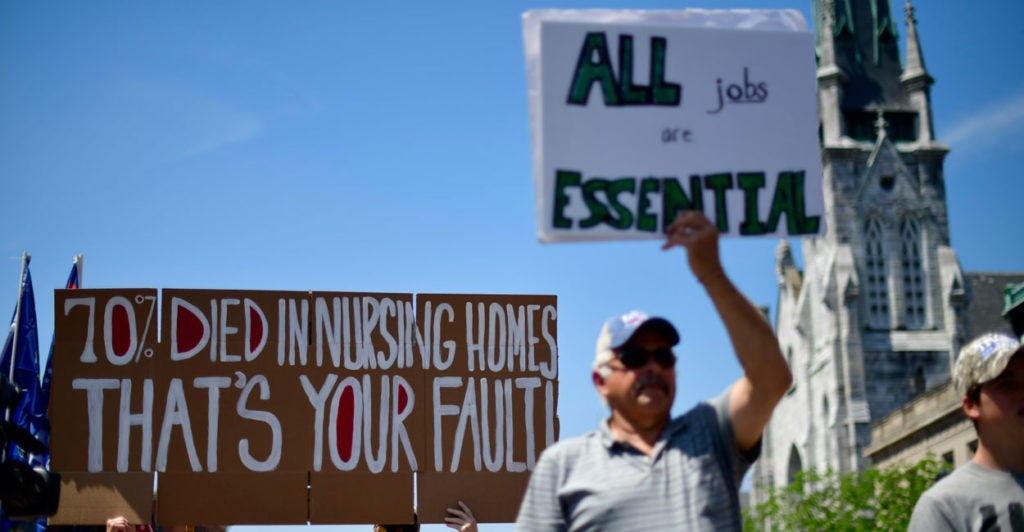Here’s a question for public policy: If you could cut the COVID-19 death rate in half, would you do it?
Policymakers could do that, if they act accordingly by greatly increasing testing of both residents and staff at nursing homes and other extended care facilities, the hottest of hot spots for coronavirus deaths.
By now, the evidence is clear. The Centers for Disease Control and Prevention cautions: “[O]lder adults and people of any age who have serious underlying medical conditions might be at higher risk for severe illness from COVID-19.”
>>> What’s the best way for America to reopen and return to business? The National Coronavirus Recovery Commission, a project of The Heritage Foundation, assembled America’s top thinkers to figure that out. So far, it has made more than 260 recommendations. Learn more here.
That risk is much higher than we first realized. Even though nursing home and long-term care residents make up only 1% of America’s total population, probably about 50% of the COVID-19 deaths have occurred among them.
Phil Kerpen, an independent policy analyst, examined data collected from a number of state public health sources. Using that nursing home data, he reported that 55.6% of all COVID-19 deaths are nursing home residents. (Some states have much higher percentages; for example, Pennsylvania, 68.7%; Connecticut, 72.3%; Minnesota, 79.4%; and New Hampshire, 82.8%.)
In any case, if 1% of the population accounts for 50%—or more—of America’s COVID-19 deaths, the country needs to pursue appropriately focused policies.
Specifically, nursing staff in nursing homes and long-term care facilities must wear masks and intensify their sanitation efforts. Beyond that, we must do universal COVID-19 testing in long-term care facilities.
Testing should include not only residents, but also staff, at those facilities. In my state of Georgia, as of mid-June, 74% of residents and only 54% of staff in long-term care facilities had been tested for COVID-19. (Georgia is typical, with 46.6% of coronavirus deaths from nursing homes.)
Minnesota, with nearly 4 of every 5 COVID-19 deaths from nursing homes, deployed the Minnesota National Guard to perform testing across the state beginning May 14.
In the May 20 edition of Skilled Nursing News, the American Health Care Association estimated that at $150 a test, the cost to universally test one time would be $440 million. That would include 1.3 million residents and 1.6 million staffers.
If the CDC guidelines were followed, and staffers were tested weekly, the cost would be $243 million per week at the current price.
Two steps are needed to make universal testing at nursing homes possible.
First, the cost per test needs to come down. Numerous companies provide tests, so it’s a competitive market to encourage innovation and economies of scale.
By way of an example, a universal testing program for hepatitis C in Egypt, a country with one of the highest rates of it in the world, resulted in virtually eliminating the disease in the population, and the cost of each test was reduced to 50 cents.
With economies of scale and competitive companies, William Haseltine, reporting in Forbes, suggested the United States could achieve similar cost reductions for COVID-19 tests.
Second, there is a legitimate federal role in helping state health authorities to cover the costs of the nursing home tests. We need to fund appropriate nursing home testing to dramatically reduce the incidence and transmission of the virus among those most likely to die from it.
Although the U.S. Department of Health and Human Services and the Centers for Medicare and Medicaid Services sent relief funds to nursing homes, the amount was based on the prior year’s Medicare reimbursement, rather than the number of residents and staff.
Federal assistance for nursing home programs should be allotted on COVID-19 testing needed for all payer groups—private insurance, Medicare, and state-funded Medicaid. Federal officials also need to monitor state-level transactions supported with federal funds to ensure that the testing companies are transparent and that test pricing is competitive to ensure a reduction in testing costs.
My belief is that we could decrease COVID-19 deaths by 50%. New knowledge of how to effectively treat the most severe cases is encouraging. We now must aggressively prevent those most likely to die from the coronavirus from ever getting it. We could, if we only would.
